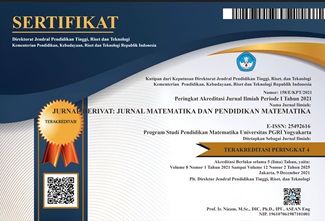Analisis Regresi Liner untuk Meramalkan Jumlah Siswa Sekolah Dasar di Cilacap
DOI:
https://doi.org/10.31316/jderivat.v10i2.6474Abstract
This research aims to determine a prediction model using Simple Linear Regression for time series data on the number of elementary school students in Cilacap from 2010 to 2023 and to obtain predicted results on the number of elementary school students in Cilacap for the following year. The data pattern of the number of elementary school students in Cilacap is known to have a decreasing trend. The time series data was subjected to the Durbin-Watson test to see whether there was autocorrelation. It was found that data on the number of elementary school students in Cilacap from 2010 to 2023 did not have autocorrelation with the Durbin-Watson (d) computing value of 1.385. The requirements for time series data have been met, so that forecasting analysis can be carried out using Simple Linear Regression and it is found that the regression equation is y ̂=168698.604-1600.519x. This regression equation is used to predict the value of the number of elementary school students in Cilacap for the next year. The forecasting accuracy level is 97.303% or with a MAPE error value of 2.697%, which means that the ability of the regression model to predict is very accurate. Thus, the predicted data on the number of elementary school students in Cilacap for the next period in 2024 is 144690 students.
Keywords: Forecasting, Time Series, Linear Regression
References
Anggrawan, A., Hairani, H., & Azmi, N. (2022). Prediksi Penjualan Produk Unilever Menggunakan Metode Regresi Linear. Jurnal Bumigora Information Technology (BITe), 4(2), 123–132. https://doi.org/10.30812/bite.v4i2.2416
Aqibah, M., Suciptawati, N. L. P., & Sumarjaya, I. W. (2020). Model Dinamis Autoregressive Distributed Lag (Studi Kasus: Pengaruh Kurs Dolar Amerika Dan Inflasi Terhadap Harga Saham Tahun 2014-2018). E-Jurnal Matematika, 9(4), 240–250. https://doi.org/10.24843/mtk.2020.v09.i04.p304
Araiza-Aguilar, J. A., Rojas-Valencia, M. N., & Aguilar-Vera, R. A. (2020). Forecast generation model of municipal solid waste using multiple linear regression. Global Journal of Environmental Science and Management, 6(1), 1–14. https://doi.org/10.22034/gjesm.2020.01.01
Ashari, M. L., & Sadikin, M. (2020). Prediksi Data Transaksi Penjualan Time Series Menggunakan Regresi Lstm. Jurnal Nasional Pendidikan Teknik Informatika (JANAPATI), 9(1), 1. https://doi.org/10.23887/janapati.v9i1.19140
Aspriyani, R., & Ahmad, M. (2023). Prediksi Jumlah Siswa Baru Menggunakan Least Square Method. Majamath: Jurnal Matematika Dan Pendidikan Matematika, 6(1), 1–12.
Aspriyani, R., & Hartono, B. P. (2021). Analisis Kemampuan Komunikasi Matematika Siswa Ditinjau dari Motivasi Berprestasi. Edumatica: Jurnal Pendidikan Matematika, 11(03), 155–164. https://online-journal.unja.ac.id/edumatica/article/view/13664/12496
Aspriyani, R., & Istikaanah, N. (2023). Analisis time s eries untuk memprediksi jumlah penduduk miskin di Cilacap. Delta-Pi: Jurnal Matematika Dan Pendidikan Matematika, 12(2). https://ejournal.unkhair.ac.id/index.php/deltapi/article/viewFile/6707/4406
Budiyono. (2009). Statistika untuk Penelitian. UNS Press.
Chang, P. C., Wang, Y. W., & Liu, C. H. (2007). The development of a weighted evolving fuzzy neural network for PCB sales forecasting. Expert Systems with Applications, 32(1), 86–96. https://doi.org/10.1016/j.eswa.2005.11.021
Hidayat, A. (2017). Pengertian dan Penjelasan Uji Autokorelasi Durbin Watson. https://www.statistikian.com/2017/01/uji-autokorelasi-durbin-watson-spss.html
Kurniawan, P., Rossa, H., Permana, A., Ramadan, W. A., Aji, A. B. W., Hidayatulloh, S., Iksan, N., & Arief, U. M. (2022). Prediksi Jumlah Penduduk Jakarta Selatan Menggunakan Metode Regresi Linear Berganda. Jurnal Sistem Dan Teknologi Informasi (JustIN), 10(4), 518. https://doi.org/10.26418/justin.v10i4.48331
Lederer, J. (2022). Linear Regression. In Fundamentals of High-Dimensional Statistics: With Exercises and R Labs (pp. 37–79). Springer International Publishing. https://doi.org/10.1007/978-3-030-73792-4_2
Madhukumar, M., Sebastian, A., Liang, X., Jamil, M., & Shabbir, M. N. S. K. (2022). Regression Model-Based Short-Term Load Forecasting for University Campus Load. IEEE Access, 10, 8891–8905. https://doi.org/10.1109/ACCESS.2022.3144206
Perdana, D. Y., & Pakereng, M. A. I. (2022). Prediksi Tingkat Pengangguran Berdasarkan Data Time Series Menggunakan Regresi Linear (Studi Kasus : Kota Salatiga). Jurnal EMT KITA, 6(2), 361–367. https://doi.org/10.35870/emt.v6i2.702
Salsabila, W. N., Fahmiah, N., Aqila, D. N., Mahardika, I. K., & Bektiarso, S. (2023). Peran Orang Tua Dalam Pembelajaran Sains Pada Anak Usia Dini. PHYDAGOGIC : Jurnal Fisika Dan Pembelajarannya, 5(2), 104–107. https://doi.org/10.31605/phy.v5i2.2201
Syahputra, H., Syahril, M., Studi Mahasiswa, P., Triguna Dharma, S., & Studi Dosen Pembimbing, P. (2020). Prediksi Jumlah Murid Baru Dengan Menggunakan Metode Regresi Linear Berganda. Jurnal CyberTech, 3(4), 671–679. https://ojs.trigunadharma.ac.id/
Downloads
Published
Issue
Section
Citation Check
License
Copyright (c) 2024 Riski Aspriyani

This work is licensed under a Creative Commons Attribution-ShareAlike 4.0 International License.
Authors who publish with this journal agree to the following terms:
-
Authors retain copyright and grant the journal right of first publication with the work simultaneously licensed under a Creative Commons Attribution-ShareAlike 4.0 International License that allows others to share the work with an acknowledgment of the work's authorship and initial publication in this journal.
- Authors are able to enter into separate, additional contractual arrangements for the non-exclusive distribution of the journal's published version of the work (e.g., post it to an institutional repository or publish it in a book), with an acknowledgment of its initial publication in this journal.
- Authors are permitted and encouraged to post their work online (e.g., in institutional repositories or on their website) prior to and during the submission process, as it can lead to productive exchanges, as well as earlier and greater citation of published work (See The Effect of Open Access).







